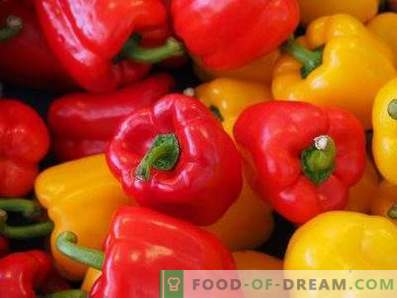
Chili is a variety of capsicum, a plant with fruits that have a specific burning taste. Homeland culture - Central America. Archaeologists who excavated ancient Peruvian burials established that they began to cultivate chili peppers in the valley of the Urubamba 6,000 years ago. Today, this vegetable crop is grown all over the world, but India, Thailand, Brazil, Mexico and Vietnam are recognized as the largest producers of its fruits.
Chili is an annual shrub with a branched stem, reaching 60 cm in height. Leaf plates of the plant are green in color, elliptical in shape with pointed tips. Pepper blooms in June, large light gray or white flowers, covered with pale purple spots. The fruit of the plant is a berry with a thin pericarp. The shape of the pods can vary from cylindrical to spherical, and color from red to greenish black.
Red pepper has a pleasant spicy aroma and burning taste. The powder obtained from the dried fruit of this plant is added to sauces, pickles, dairy drinks, salad dressings, as well as to egg, cereal, meat and vegetable dishes. Whole peppers put in borscht and other soups during cooking. Powder from dried fruits of a plant are actively used in official and non-traditional medicine.
Nutritional value of chili pepper
100 g of chili pepper contains:
- 1, 837 g of proteins;
- 0, 384 g of fat;
- 7, 212 g of carbohydrates;
- 1, 431 g of dietary fiber;
- 88, 009 g of water;
- 0, 862 g of ash;
- 5, 294 g of sugars;
- 0, 009 g of omega-3 fatty acids;
- 0, 226 g of omega-6 fatty acids.
The burning taste of the fruit of the plant is due to the presence of the alkaloid capsaicin in their composition. The approximate content of this compound in the pods is 0, 2% of their total weight. The highest concentration of capsaicin is in the skin, veins and seeds of pepper.
Vitamins in red hot pepper
100 g of red hot pepper contains the following vitamins:
- retinol equivalent, A - 47, 911 μg;
- thiamine, B1 - 0, 071 mg;
- choline, B4 - 10, 877 mg;
- ascorbic acid, C - 143, 621 mg;
- riboflavin, B2 - 0, 084 mg;
- pyridoxine, B6 - 0, 504 mg;
- phylloquinone, K - 13, 211 mcg;
- pantothenic acid, B5 - 0, 199 mg;
- tocopherol equivalent, E - 0, 681 mg;
- folate, B9 - 22, 783 mkg;
- Niacin equivalent, PP - 1, 238 mg.
Calories of chili pepper
100 g of fresh chilli contains 39, 819 kcal. The energy value of one medium-sized fruit (about 18 g) is 7, 167 kcal.
In 100 g of ground red hot pepper - 344, 628 kcal. The caloric value of a teaspoon of this product (6 g) is 20, 678 kcal, a tablespoon (18 g) is 62, 033 kcal.
Useful items in red hot pepper
Macro elements in 100 g of product:
- potassium - 321, 684 mg;
- phosphorus - 42, 732 mg;
- magnesium - 22, 901 mg;
- calcium - 13, 806 mg;
- sodium - 8, 916 mg.
Trace elements in 100 g of chili pepper:
- copper - 128, 669 mkg;
- manganese - 0, 186 mg;
- zinc - 0, 258 mg;
- selenium - 0, 498 mkg;
- iron - 1, 027 mg.
How to choose and store chili peppers
When buying fresh chilli, preference should be given to medium-sized fruits with dense smooth skin and a uniform red color. On the surface of the pods should not be wrinkles, cracks, stains and other damage. Store the fruit of the plant in the refrigerator (no more than 14 days) or in the freezer (up to 12 months).
The color of dried chillies can range from orange-red to burgundy. Quality pods should be resilient, whole. It is important to ensure that there is no bloom, dark spots or cobwebs on the surface of the pepper. The product should be stored in a dry dark place in a glass jar or a thick canvas bag. The shelf life is 1, 5 years.
The benefits of red hot pepper
- With moderate consumption of chili peppers, endorphin production is accelerated, mood improves, irritability disappears, the adverse effect of stress on the body decreases, and the risk of seasonal depression develops.
- The compounds that make up this product have analgesic properties. People who regularly add it to food have the opportunity to ease pain in shingles, migraines, arthritis, catarrh of the respiratory system, gout and rheumatism.
- Regular consumption of dishes in which there is a hot pepper, contributes to the improvement of mental and physical performance, general body tone.
- Chile is an effective remedy for insomnia.
- Red pepper helps to strengthen the immune system, increase the body's resistance to colds.
- Compounds with bactericidal properties are present in chili peppers. Therefore, dishes with this spice in the composition is useful to include in the diet of people who have been identified infectious diseases provoked by bacterial microflora.
- It has been proven that the immature fruits of a plant contain substances that lower blood pressure. Nutritionists recommend people suffering from hypertension, include them in the diet at least once a week.
- In folk medicine, hot red pepper is used as a means of stimulating the production of digestive juice and increases appetite. The compounds present in the composition of this product, have light laxative properties, help to get rid of bloating, prolonged constipation and flatulence.
- It has been proven that moderate consumption of food with the addition of chili helps to speed up the body's metabolism and accelerate the process of losing weight in people suffering from obesity.
- The substances present in the composition of this spice help to lower the concentration of sugar in the blood.
- Specialists from the University of Nottingham (United Kingdom) were able to prove that capsaicin contained in red hot pepper can cause massive death of cancer cells. Regular (at least 3-4 times a week) consumption of dishes that contain this spice, helps reduce the risk of developing cancer, slow down the growth of already formed tumors.
- The substances that hot peppers are rich in help to minimize the adverse effects of heart attacks on the body.
- Chili pepper has irritant properties. Therefore, the powder obtained from its dried fruit is used to produce mustard plaster, patches and liniments.
- Useful compounds, which are rich in hot chili peppers, strengthen the walls of blood vessels, give them elasticity, contribute to the elimination of excess cholesterol from the body. With regular inclusion in the menu of dishes that include this spice, the risk of developing heart disease is significantly reduced.
- Dishes flavored with red hot pepper improve the condition of people suffering from sensory disorders and diseases of the central nervous system.
- Chili accelerates blood microcirculation, prevents the appearance of blood clots.
- Antioxidant compounds that are rich in chilli help to maintain the beauty and youthfulness of the skin for a long time, slow down the aging processes of tissues.
- Masks made on the basis of vegetable oils with the addition of ground hot pepper help to accelerate hair growth and prevent their pathological loss.
Contraindications and harm to chili pepper
- Chili can cause allergic reactions. Therefore, people who have previously been identified allergies to spices, you should abandon this product.
- Spicy dishes with the addition of hot peppers are contraindicated for pregnant women and young mothers who are breastfeeding.
- Excessive consumption of ground hot pepper and dishes prepared from it can cause diseases of the digestive tract, provoke internal burns.
- Chilli is contraindicated for people suffering from ulcerative colitis, duodenal or gastric ulcers, gastritis that has developed against the background of an increase in the acidity of gastric juice.
- Some chilli varieties are so hot and hot that they can cause irritation of the skin or mucous membranes, even with brief contact. That is why when processing the fruits of this plant you need to use rubber gloves. The areas of the skin, irritated by the burning juice of pepper, should be washed under running cold water and treated with any vegetable oil.























